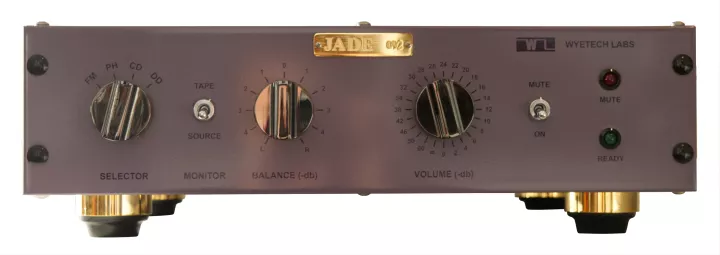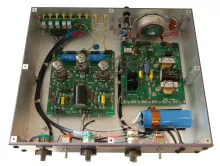Line stage preamplifier

After having been on the market less than a year the Opal preamp has been accepted as the leading edge in sound reproduction. We have developed the Jade to mimic it as close as possible, while making it more affordable to a wider audience. We've retained the grounded grid configuration which we deem to be the best possible circuit topology for line level amplification. Having only one buffered output allowed us to reduce the tube count to three double octal based triodes. This circuit, like the Opal, maintains an exceptional bandwidth that extends well beyond 250,000Hz. Our primary design philosophy that less is better than more has been fully developed in the Jade preamp.
Circuit Description
The Jade has been upgraded with the analog circuit and power supply taken from the Pearl. In addition a new selector circuit board mounts to the back of the input RCA connectors and now uses relay switching for all functions. Front panel selector and tape monitor switch, now control the relays, which handle the routing of the signal. Previous coax wiring running from the rear to the front selector & monitor switch has been eliminated, reducing the length of the signal path while eliminating much wiring and labor cost. This also enhances the life expectancy and reliability.
As a consequence the Pearl name has been discontinued and the new product will retain the name of the Jade. The new unit will sport the 24K gold plated knobs previously used on the Pearl. The Jade's former black nickel knobs will still be available while supplies last at a no cost option
This line amp uses a grounded grid configuration which is isolated by a cathode follower stage before and after it. All three stages are non-inverting thereby maintaining absolute phase. The grounded grid configuration is known for its extremely wide bandwidth and high speed! Each channel cathode follower is provided with two RCA output jacks to accommodate bi-wiring or bi-amping. All stages are DC coupled and only one capacitor is used in the output stage for DC blocking. No feedback is used and mirror image circuitry is implemented using a separate circuit board for the audio section.
Power Supply
A unique design for the power supply was implemented in order to eliminate all ripple and noise.
The power supply is built on a separate terminal board, and uses passive shunt regulation of the 200 volt DC supply.
A dual π (pi) filter, consisting of two large chokes, a large electrolytic reservoir capacitor, several polypropylene capacitors and an array of high power (30 W) zener diodes are used to shunt the current while stabilizing the DC voltage level, providing exceptional power for the analog circuitry.
This filter is designed using only passive components that allow the speed of the power supply to keep up with the analog circuitry. DC for the filaments is supplied using a solid state 3 terminal regulator for hum free operation.
We have avoided using active feedback in order to maintain the speed of the power supply in relation to the extremely fast analog circuitry. Stability is ensured by the use of a large electrolytic reservoir capacitor and speed is enhanced by using a large (30µf) polypropylene film capacitor as a final filter stage located directly on the analog terminal circuit board. The Jade 200 volt DC power supply completely eliminates all noise and ripple to below what our test instruments can detect. An AC power line filter is also used to prevent unwanted noise and hash from entering into the unit.
Parts
We use precision quality parts throughout.
We import our stepped ELMA volume controls from Denmark - they use 0.1% precision metal film surface mount resistors that are second best in life expectancy only to the Shallco military switches used in the Opal.
Since perfection is our goal, we don't think parts should impart a signature sound but rather allow the sound to flow through unaltered. The type of parts used therefore must have a synergistic relationship to the circuit in which they are placed. It is this relationship of which type of part to use where, that ranks our products apart from the crowd!
Mechanical Construction
- Machined aluminum plates (1/4 in. & 1/8 in. thick) bolted to square post are used to construct the preamp chassis. This provides excellent shielding from external radio frequency fields.
- Hard gold plated solid machined brass knobs for smooth operation of switches.
- The stepped Volume control has gold plated contacts with surface mounted 0.1% precision metal film resistors. (channel balance within +/- 0.05 dB)
- Selector & Balance controls use precision Shallco with silver alloy contacts.
- Noiseless TOROIDAL power transformer and NKK rugged quality toggle switches
- Non magnetic stainless steel and brass hardware is used throughout.
- Automotive high gloss paint finish.
Circuit Boards
Hand crafted printed circuit boards using precision double turret terminal posts
Our fixed terminal hand crafted printed circuit boards are a new technology used in construction and is a first in the industry. Again Wyetech Labs is at the forefront and is always looking for ways to improve reliability and construction.
Most of the components are mounted on double turret terminal post. The octal tube sockets are also hard wired to these fixed terminals which in turn are soldered to the printed circuit board. This makes the tube sockets easily replaceable should the need ever arise. Chips and relays are mounted in sockets which are soldered to the board.
The double sided printed circuit board [ PCB ] has been manufactured with the same high standards as that found in the Sapphire amplifier. It has full solder masking on both sides of it's premium glass epoxy board with white silk screening that identifies parts and there placement for fast efficient hand soldering and assembly. These boards are held elevated from the surrounding metal chassis to avoid any capacitive coupling between components.
We also use WECO screw terminal connectors to fasten wires to the PC board to facilitate easier replacement of parts for future reparability and long service life. This technique will result in much faster trouble shooting and repair in the event of a failure and thereby reduce the labor and cost of any necessary repair.
High quality Teflon coated silver plated OFHC copper wiring is used where appropriate to make connections to and from each board and silver solder is used throughout.
Automatic Power Sequencing and Muting
To allow circuit stabilization and quite operation a 45 second automatic muting is activated during power up. Muting is accomplished using a 2-pole relay that shorts the preamp outputs. When disengaged the muting circuit is not in the signal path.
Selectable Gain Control
Overall amplifier gain is controled by a toggle switch for each channel. Gain can be switched between:
- HIGH 13 dB (4.4x), and
- LOW 5.5 dB (1.85x)
To change the gain settings, you must remove the top cover. The analog board on the left contains the left and right channel switches to select high or low gain.
Specifications
| Tube Complement | 3 - 6SN7GT Valve Art dual triode |
|---|---|
| Frequency Response | reference to a sine wave at 3.5 Vrms output
|
| Input Impedance | 50K ohms minimum |
| Absolute Phase | non-inverting |
| Channel Balance Control | 11 position for +/- 5 dB adjustment in 1 dB steps |
| Attenuation | 24 position stepped volume control (-60 dB to 0 dB) |
| Output Impedance | 600 Ohms |
| Rated Output | 3.5 Vrms (maximum = 8.5 Vrms) |
| Slew Rate | Greater than 25 Volts/microsecond. |
| Outputs |
|
| Inputs |
|
| Power Requirements |
|
| Net Weight | 18 lbs (7.8 kg) |
| Shipping Weight | 23 lbs (10 kg) |
| Dimensions | 17 in. W x 14 1/4 in. D x 4 1/4 in. H |
Reviews
Bound for Sound
Issue # 187 July 2008 - Reviewed by Martin G. DeWulf
Martin G. DeWulf compares three preamplifiers
I believe this preamp's greatest and most formidable asset may be its ability to portray the aural contexts of a performance, especially live performances, at arm's length; all without sacrificing the emotive mix required to mesh music with realism.
6moons
July 2006 - Reviewed by Srajan Ebaen
Srajan states:
… let's be content to say that preceding the Yamamoto with the Jade seems to benefit dynamic range as well…
The Inner Ear Report
Volume 12, # 1 (1999) - Reviewed by Ernie Fisher
the makeup of the Jade closely resembles that of the Opal in all attributes…
AVGuide
April 2002 - Reviewed by Scot Markwell
Scot thought the Jade to be one of the finest line stages he has ever heard in his system. He assessed it as being ultra quiet, extremely dynamic and uncompromised in presentation giving a clean and neutral tonal balance.
SoundStage!
November 1999 - Reviewed by Jeff Fritz
Jeff found a lot to like about the jade and concluded it to be well executed in all areas and a contender for all systems and was especially surprised at the low noise level.
…the Jade is the quietest tube line stage I’ve heard…
The Wyetech Jade successfully combines sonic excellence with sound design and build integrity.
I’d be hard-pressed to recommend a better-sounding line stage.
Warranty
Limited Warranty
Tubes: 1 year parts
Components: 5 years parts and labor

